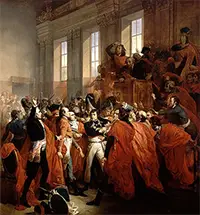The War of the Second Coalition
Part 2: French Highs and Lows
In the meantime, a British-Russian force invaded the Batavian Republic, which had been the Dutch Republic before France assumed control of it during the previous war. The coalition forces had early success at Krabbendam in September and at Alkmaar in October. The retreating French forces flooded a handful of lakes, leaving the invaders no fresh food and little potable water. At Castricum on October 8, the two sides collided, trading artillery fire, attacks, and counterattacks, and cavalry charges. The last of these, by the French, seized the day, and the British and Russians retreated far to the north and then evacuated completely, having done considerable damage to the Batavian Republic army and the navy, the French army, and French prestige. When Bonaparte arrived back in Paris, the country as a whole and Paris in particular were in a state of uncertainty. Especially troubling was the political situation in the capital and in the government itself. The Councils called for a forced loan of a large sum of money, in order to finance the ongoing war effort and to keep the government finances afloat; as well, the Councils called for a new round of conscription, the first since 1793. 
The end of the Directory came in 1799, as the result of the Coup of 18 Brumaire. Emmanuel-Joseph Sieyès, a leader of the Revolution from as far back as the late 1780s, won election to the Directory. He then overthrew the government. A plan of subterfuge, aided by Bonaparte, eventually succeeded in creating a new government. In this case, the government was the Consulate, which placed maximum power in the hands of a very few. This, many historians say, was the end of the French Revolution. The Constitution, endorsed by a plebiscite in February 1800, named Napoleon as First Consul and gave him most of the government's powers and responsibilities. Effectively a dictator, Bonaparte returned to the business of winning the war. Next page > Toward the End of the War > Page 1, 2, 3 |
|
Social Studies for Kids
copyright 2002–2024
David White



 Napoleon and his army were trapped in the Middle East. He set about taking over Egypt, reorganizing its administration along the lines of Western institutions. It wasn't long before Turkey declared war on France. To forestall a full-blown invasion by Turkish forces, the French army in February 1799 marched into Syria. They traveled up the coast, conquering the ancient towns of Gaza, Haifa, and Jaffa. At Acre they found defeat at the hands of the British-Turkish force there and distress at the hands of the plague, which had struck the French army. A frustrated Bonaparte ordered a return to Egypt. On July 25, 1799, he fought off an Ottoman invasion of Alexandria. A month later, Bonaparte, hearing of the political instability in France, sailed for home.
Napoleon and his army were trapped in the Middle East. He set about taking over Egypt, reorganizing its administration along the lines of Western institutions. It wasn't long before Turkey declared war on France. To forestall a full-blown invasion by Turkish forces, the French army in February 1799 marched into Syria. They traveled up the coast, conquering the ancient towns of Gaza, Haifa, and Jaffa. At Acre they found defeat at the hands of the British-Turkish force there and distress at the hands of the plague, which had struck the French army. A frustrated Bonaparte ordered a return to Egypt. On July 25, 1799, he fought off an Ottoman invasion of Alexandria. A month later, Bonaparte, hearing of the political instability in France, sailed for home.
